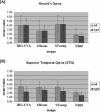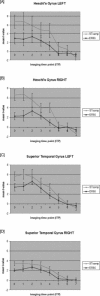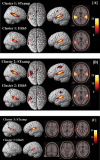Assessing the influence of scanner background noise on auditory processing. I. An fMRI study comparing three experimental designs with varying degrees of scanner noise
- PMID: 17080440
- PMCID: PMC6871450
- DOI: 10.1002/hbm.20298
Assessing the influence of scanner background noise on auditory processing. I. An fMRI study comparing three experimental designs with varying degrees of scanner noise
Abstract
We compared two experimental designs aimed at minimizing the influence of scanner background noise (SBN) on functional MRI (fMRI) of auditory processes with one conventional fMRI design. Ten subjects listened to a series of four one-syllable words and had to decide whether two of the words were identical. This was contrasted with a no-stimulus control condition. All three experimental designs had a duration of approximately 17 min: 1) a behavior interleaved gradients (BIG; Eden et al. [1999] J Magn Reson Imaging 41:13-20) design (repetition time, TR, = 6 s), where stimuli were presented during the SBN-free periods between clustered volume acquisitions (CVA); 2) a sparse temporal sampling technique (STsamp; e.g., Gaab et al., [2003] Neuroimage 19:1417-1426) acquiring only one set of slices following each of the stimulations with a 16-s TR and jittered delay times between stimulus offset and image acquisition; and 3) an event-related design with continuous scanning (ERcont) using the stimulation design of STsamp but with a 2-s TR. The results demonstrated increased signal within Heschl's gyrus for the STsamp and BIG-CVA design in comparison to ERcont as well as differences in the overall functional anatomy among the designs. The possibility to obtain a time course of activation as well as the full recovery of the stimulus- and SBN-induced hemodynamic response function signal and lack of signal suppression from SBN during the STsamp design makes this technique a powerful approach for conducting auditory experiments using fMRI. Practical strengths and limitations of the three auditory acquisition paradigms are discussed.
We compared two experimental designs aimed at minimizing the influence of scanner background noise (SBN) on functional MRI (fMRI) of auditory processes with one conventional fMRI design. Ten subjects listened to a series of four one‐syllable words and had to decide whether two of the words were identical. This was contrasted with a no‐stimulus control condition. All three experimental designs had a duration of ∼17 min: 1) a behavior interleaved gradients (BIG; Eden et al. [1999] J Magn Reson Imaging 41:13–20) design (repetition time, TR, = 6 s), where stimuli were presented during the SBN‐free periods between clustered volume acquisitions (CVA); 2) a sparse temporal sampling technique (STsamp; e.g., Gaab et al., [2003] Neuroimage 19:1417–1426) acquiring only one set of slices following each of the stimulations with a 16‐s TR and jittered delay times between stimulus offset and image acquisition; and 3) an event‐related design with continuous scanning (ERcont) using the stimulation design of STsamp but with a 2‐s TR. The results demonstrated increased signal within Heschl's gyrus for the STsamp and BIG‐CVA design in comparison to ERcont as well as differences in the overall functional anatomy among the designs. The possibility to obtain a time course of activation as well as the full recovery of the stimulus‐ and SBN‐induced hemodynamic response function signal and lack of signal suppression from SBN during the STsamp design makes this technique a powerful approach for conducting auditory experiments using fMRI. Practical strengths and limitations of the three auditory acquisition paradigms are discussed. Hum Brain Mapp, 2006. © 2006 Wiley‐Liss, Inc.
2006 Wiley-Liss, Inc.
Figures








Similar articles
-
Assessing the influence of scanner background noise on auditory processing. II. An fMRI study comparing auditory processing in the absence and presence of recorded scanner noise using a sparse design.Hum Brain Mapp. 2007 Aug;28(8):721-32. doi: 10.1002/hbm.20299. Hum Brain Mapp. 2007. PMID: 17089376 Free PMC article.
-
Reducing the interval between volume acquisitions improves "sparse" scanning protocols in event-related auditory fMRI.Brain Topogr. 2012 Apr;25(2):182-93. doi: 10.1007/s10548-011-0206-x. Epub 2011 Oct 21. Brain Topogr. 2012. PMID: 22015572
-
Silent and continuous fMRI scanning differentially modulate activation in an auditory language comprehension task.Hum Brain Mapp. 2008 Jan;29(1):46-56. doi: 10.1002/hbm.20372. Hum Brain Mapp. 2008. PMID: 17318832 Free PMC article.
-
Study design in fMRI: basic principles.Brain Cogn. 2006 Apr;60(3):220-32. doi: 10.1016/j.bandc.2005.11.009. Epub 2006 Jan 19. Brain Cogn. 2006. PMID: 16427175 Review.
-
Using neuroimaging to understand the cortical mechanisms of auditory selective attention.Hear Res. 2014 Jan;307:111-20. doi: 10.1016/j.heares.2013.06.010. Epub 2013 Jul 9. Hear Res. 2014. PMID: 23850664 Free PMC article. Review.
Cited by
-
The neural correlates of picture naming facilitated by auditory repetition.BMC Neurosci. 2012 Feb 27;13:21. doi: 10.1186/1471-2202-13-21. BMC Neurosci. 2012. PMID: 22364354 Free PMC article.
-
On-line plasticity in spoken sentence comprehension: Adapting to time-compressed speech.Neuroimage. 2010 Jan 1;49(1):1124-32. doi: 10.1016/j.neuroimage.2009.07.032. Epub 2009 Jul 24. Neuroimage. 2010. PMID: 19632341 Free PMC article.
-
The effect of ageing on fMRI: Correction for the confounding effects of vascular reactivity evaluated by joint fMRI and MEG in 335 adults.Hum Brain Mapp. 2015 Jun;36(6):2248-69. doi: 10.1002/hbm.22768. Epub 2015 Feb 27. Hum Brain Mapp. 2015. PMID: 25727740 Free PMC article.
-
Investigating the neural correlates of voice versus speech-sound directed information in pre-school children.PLoS One. 2014 Dec 22;9(12):e115549. doi: 10.1371/journal.pone.0115549. eCollection 2014. PLoS One. 2014. PMID: 25532132 Free PMC article.
-
Self-specific stimuli interact differently than non-self-specific stimuli with eyes-open versus eyes-closed spontaneous activity in auditory cortex.Front Hum Neurosci. 2013 Jul 29;7:437. doi: 10.3389/fnhum.2013.00437. eCollection 2013. Front Hum Neurosci. 2013. PMID: 23908625 Free PMC article.
References
-
- Ackermann H, Mathiak K, Yvry RB ( 2004): Temporal organization of “internal speech” as a basis for cerebellar modulation of cognitive functions. Behav Cog Neurosci Rev 3: 14–22. - PubMed
-
- Amaro E, Williams SCR, Shergill SS, Fu CHY, MacSweeney M, Picchioni MM, Brammer MJ, McGuire PK ( 2002): Acoustic noise and functional magnetic resonance imaging: current strategies and future prospects. J Magn Reson Imaging 16: 497–510. - PubMed
-
- Andreasen NC, O'Leary DS, Cizadlo T, Arndt S, Rezai K, Watkins GL, Ponto LL, Hichwa RD ( 1995): II. PET studies of memory: novel versus practiced free recall of word lists. Neuroimage 2: 296–305. - PubMed
-
- Bandettini PA, Jesmanowicz A, Van Kylen J, Birn RM, Hyde JS ( 1998): Functional MRI of brain activation induced by scanner acoustic noise. Magn Reson Med 39: 410–416. - PubMed
-
- Baumgart F, Gaschler‐Markefski B, Tempelmann C, Tegeler C, Heinze HJ, Scheich H ( 1996): Masking of acoustic stimuli by the gradient noise alters the fMRI detectable activation in a particular human auditory cortex. MAGMA 4: 185.
Publication types
MeSH terms
Grants and funding
LinkOut - more resources
Full Text Sources
Medical

